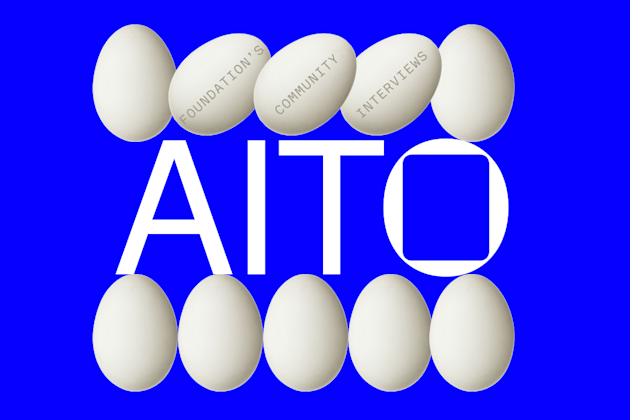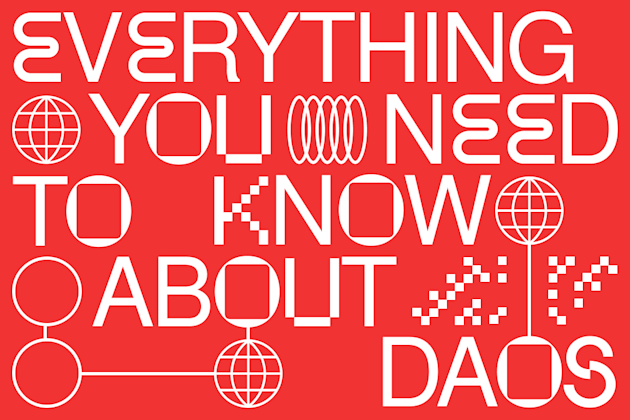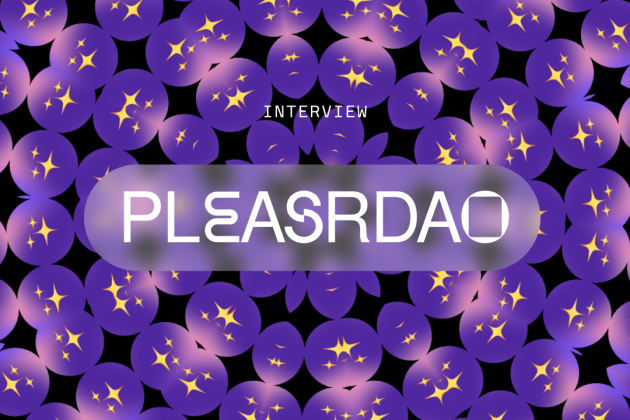exonemo on communicating love and hate for NFTs.

Sembo and Yae formed the artist duo exonemo in 1996. Since then, the two have continued to collaborate on experimental projects that explore the contradictions between digital and analog environments. Often taking a humorous and innovative approach, their work has been exhibited internationally. Their project, The Road Movie, won the Golden Nica in the Net Vision category of the Prix Ars Electronica, and their web piece, 0 to 1 / 1 to 0, was commissioned by the Whitney Museum in 2019.
exonemo is perhaps most well-known for starting the Internet Yami-ichi together in 2012. Translated as “black market” in Japanese, the Yami-ichi is an international flea market that brings the immaterial ephemera of internet culture offline for IRL browsing.
We talked to the two of them about their recent project, I randomly love/hate NFTs, which cycles through three hundred computer-generated adverbs to describe a vast range of feelings toward NFTs—some are critical, while others are more mixed, or aspirational. At times, the conversation doesn’t appear to make sense at all. Love it or hate it, exonemo is literalizing how the conversation surrounding NFTs can vary between ambivalence, mutual understanding, disagreement and even confusion.
Can you introduce yourselves and explain a bit more about exonemo for those unfamiliar with your work?
Sembo: We started our activities together in the late nineties, around 1996. It felt like the beginning of the internet itself. We started making pieces on the internet first. Before that, we didn't do exhibitions or participate in other art activities—we just started with the internet.
You could say that we were part of the first generation of net artists. Not so many people used the internet as an expression of art, or an art tool, at the time. We didn't even originally think the pieces we uploaded on the internet were art. It was just something—some game, or, I don't know. We didn't know what we were doing, but we thought we should do something fun with the internet. That’s how we started. Maybe a similar situation is happening right now with the NFT moment.
So you have been creating internet art for over two decades, taking your browser-based work into physical spaces with installations, and then bringing it back online. How do you feel about the broadening concept of internet art with the introduction of NFTs?
Sembo: I think that the concept of NFTs is still very new. Somehow, there’s still a bit of a contradiction between the old type of net art or net culture, and this new type of blockchain culture, because the blockchain is based on this idea of decentralized ownership. Internet culture, especially in the beginning, was more about freedom. I think it’s very interesting, because now internet culture can have this idea of authenticity, or ownership, but still maintain freedom—we don't need to choose one way versus another. So I think that it’s ultimately a good thing for net culture.
When you started actively engaging with art online, there was a rich community of net artists in dialogue with one another, like Jodi, Vuk Cosic, and Ubermorgen. What was the landscape of artists like in Japan at that time?
Sembo: It was small and there were few people.
Yae: I think there were many interesting things happening at the time, but no one was making net art. I think that internet art originally came from European and American cultures. We connected with them, with other early net artists. Japanese net culture is a little bit separated from that culture. I mean, many, many interesting things were happening, like in gaming, but they had no connection with internet art. With Internet Yami-Ichi, we actually wanted to create relationships between the Japanese internet culture, and internet art. That was one reason we started Internet Yami-Ichi.
With ventures like Internet Yami-ichi, your online black market translated into IRL “browsing,” are you thinking about novel ways to approach e-commerce, or consumerism, in the age of the “lifestyle brand”?
Sembo: The concept of Internet Yami-Ichi is something like an escape from the internet. Once social media and major companies started to shape and control the internet, there were all these terms and conditions...so if you did anything weird, you might get banned. We just wanted to escape that a little bit and enjoy the freedom of the internet from the viewpoint of real life. A lot of ideas from the internet don’t exist in actual space.
Yae: We also wanted to rethink what the internet is. How the word “internet” reflects our life. And it was a great chance to meet people in person.
What kind of products would you bring to Internet Yami-Ichi ?
Sembo: Yeah. At the first Yami-Ichi I sold the Spacer GIF, like a transparent GIF image. It was used in the ancient web design space, before CSS. Of course, there was nothing on the table–I just put a borderline on the table and sold the air.
Yae: People could order any size of it. It was scalable.
Sembo: Somebody also sold a cookie, a real browser cookie—a lot of product ideas based on the internet.
There was also an emoji dice?
Sembo: Yeah—at the moment emoji started having different skin tones there were six. We made this for people to have equality for their project or something—like if you are doing a film casting or something, you can make your choices randomly. Some people did performances—one guy, from the original Yami-Ichi, was wearing a white bodysuit, and he performed the idea of a “follower” from the internet. People would pay him money, and then he would just follow them.
It’s always very unique.
I wanted to talk to you also about your first NFT. It’s called I Randomly Love/Hate NFTs, and it's a riff on your earlier project which is titled I Randomly Love You/Hate You (2018).
Can you talk to me a little bit more about the original project and how you translated it for Foundation?
Sembo: Yes. We made that in 2018 for an exhibition in Japan. In the original, we used two monitors showing the messaging interface. The two are connected, in sync. Each screen only shows one person’s screen, so when somebody sends a message it disappears on the other side.
And the conversation is generated from the computer, so the adverb in the middle is always randomly changing. We prepared 300 adverbs. So sometimes, the conversation made sense and sometimes it did not totally make sense.
Yae: The idea was from how we are now really, depending on the surface of the interface. Everything is happening on just a few millimeters of surface like—somebody likes me, or somebody hates me. The communication we generated is as fake as those interactions. It’s not actually happening, but the real emotional affect happens on the outside.
So you came to this version where you replaced the word “you” with “NFTs” to play with the emotional response people are having about NFTs?
Sembo: Exactly. Before we started this NFT, we saw a lot of excitement, but also some negative comments. I understood both sides. We couldn't decide which was right, or which was wrong. So we updated our old piece to respond to the current NFT situation. It’s not fixed. It's still going to keep going and being controversial, a continuous debate, or something like that. It’s just a conversation about these circumstances right now. One thing I want to mention is when I browse Foundation webpage, I feel a similar feeling as I’d get with the Internet Yami-Ichi. It’s kind of chaotic. Something new is happening there.
Read more

Guest Blog: A community interview with a mysterious egg.

Everything you need to know about DAOs.
